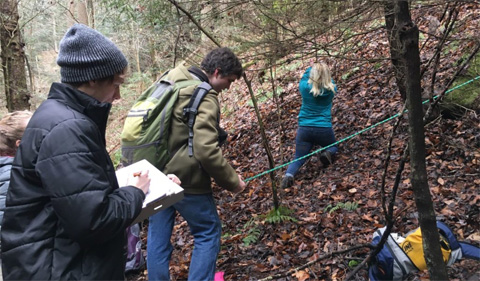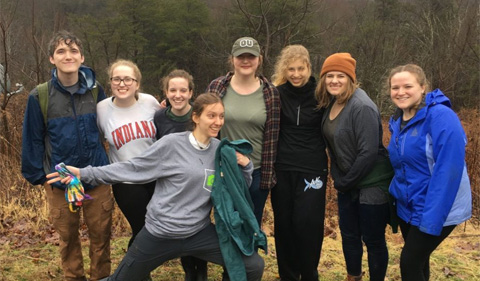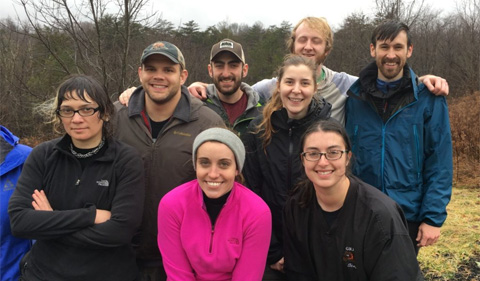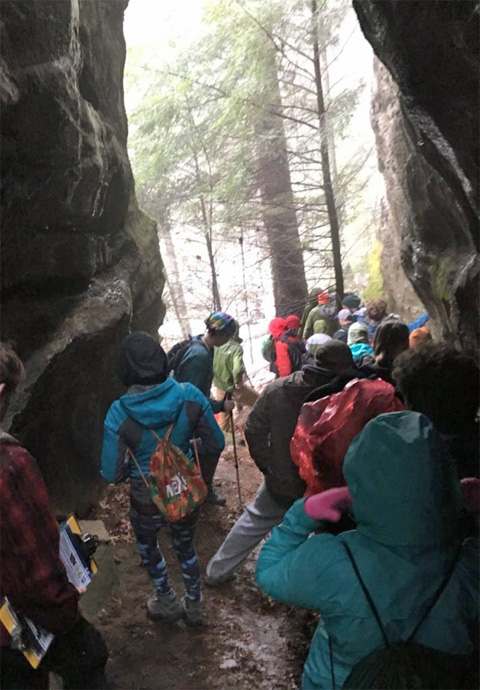
Connor Hall, Eugene Hancock and Halee Smith record tree abundance and take measurements during a March 2017 inventory.
Sixteen Environmental & Plant Biology students braved cold, rainy weather and icy ground to search for the Hemlock Wooly Adelgid, an invasive insect species that is threatening the hemlock forest ecosystems across Appalachia on Feb. 11.
Student members of the Plant Club and the Plant Biology Graduate Student Association joined other community volunteers in a monitoring effort to help protect our native forests ecosystems. Naturalist Joe Moosbrugger organized and led the effort in a Hocking Hills preserve.

Plant Club members still in good spirits after a rigorous and wet day off trail.
From left: Eugene Hancock, Melody Weary, Maya Ware, Alberta Dempsey, Gracie Jahn, Jessica Langguth, Elisabeth Bacon and Bailey Smith.
The area the students surveyed is dominated by old growth hemlock forest that could rapidly disappear if the invasive hemlock establishes itself in these areas.
In March 2017, students contributed to an inventory of hemlock trees in the forests, and this year’s task was to survey areas that had been inventoried several years before. Forest sections need to be monitored each year to identify any HWA presence since they reproduce rapidly and treatment strategies would need to be undertaken.

Plant Biology Graduate Student Associations members after hiking the hills in search of invasive hemlodk. From left: Marion Holmes, Al Meyers, Danny Wolf, Sarah Smith, Jack Monsted, Austin Waag, and Kelsey Bryant and Jen Hastings (in front)
Monitoring was accomplished by examining individual hemlock trees for the presence of a white, waxy substance, which looks like cotton, at the base of the needles. These are the ovisacs where hundreds of eggs are laid by a single insect. It was important to be able to distinguish evidence of native insect pests, such as the Hemlock Needleminer, from the ovisacs of the non-native HWA. The development of the juvenile HWA during the winter season makes this an important time for monitoring before the insects emerge as adults.
The HWA was accidentally introduced from Asia and has no natural enemies here. In addition, the hemlock trees in the Eastern United States did not evolve with the species and lack the resistance traits found in Asian trees that are natural hosts for the HWA. Half of the native range of the Eastern hemlock, at least 17 states, has already been infested, according to the USDA Forest Service. More information about the species is available from the USDA and the Ohio Department of Natural Resources, including photos that will aid in identification.
This event was an excellent opportunity for undergraduate and graduate students to contribute to the protection of our native forests while learning more about the native species and the impact of the invasive HWA.
The PBIO Graduate Student Association meets to develop and provide outreach to the community and plan workshops and events that support their personal, academic and professional development.
The Plant Club is made up of undergraduate students who enjoy learning about plants and the local environment, seek to promote awareness of environmental and conservation issues and are interested in working together to advance their academic and professional success.
Contributed by Dr. Kim Thompson, Lecturer of Environmental & Plant Biology.
















Comments